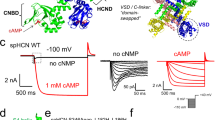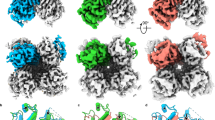Abstract
Voltage-gated ion channels underlie rapid electric signaling in excitable cells. Electrophysiological studies have established that the N-terminal half of the fourth transmembrane segment (NTS4) of these channels is the primary voltage sensor, whereas crystallographic studies have shown that NTS4 is not located within a proteinaceous pore. Rather, NTS4 and the C-terminal half of S3 (CTS3 or S3b) form a helix-turn-helix motif, termed the voltage-sensor paddle. This unexpected structural finding raises two fundamental questions: does the paddle motif also exist in voltage-gated channels in a biological membrane, and, if so, what is its function in voltage gating? Here, we provide evidence that the paddle motif exists in the open state of Drosophila Shaker voltage-gated K+ channels expressed in Xenopus oocytes and that CTS3 acts as an extracellular hydrophobic 'stabilizer' for NTS4, thus biasing the gating chemical equilibrium toward the open state.
This is a preview of subscription content, access via your institution
Access options
Subscribe to this journal
Receive 12 print issues and online access
$209.00 per year
only $17.42 per issue
Buy this article
- Purchase on SpringerLink
- Instant access to full article PDF
Prices may be subject to local taxes which are calculated during checkout









Similar content being viewed by others
Accession codes
References
Armstrong, C.M. & Bezanilla, F. Currents related to movement of the gating particles of the sodium channels. Nature 242, 459–461 (1973).
Noda, M. et al. Primary structure of Electrophorus electricus sodium channel deduced from cDNA sequence. Nature 312, 121–127 (1984).
Catterall, W.A. Molecular properties of voltage-sensitive sodium channels. Annu. Rev. Biochem. 55, 953–985 (1986).
Yang, N., George, A.L. Jr. & Horn, R. Molecular basis of charge movement in voltage-gated sodium channels. Neuron 16, 113–122 (1996).
Larsson, H.P., Baker, O.S., Dhillon, D.S. & Isacoff, E.Y. Transmembrane movement of the shaker K+ channel S4. Neuron 16, 387–397 (1996).
Mannuzzu, L.M., Moronne, M.M. & Isacoff, E.Y. Direct physical measure of conformational rearrangement underlying potassium channel gating. Science 271, 213–216 (1996).
Stühmer, W. et al. Structural parts involved in activation and inactivation of the sodium channel. Nature 339, 597–603 (1989).
Papazian, D.M., Timpe, L.C., Jan, Y.N. & Jan, L.Y. Alteration of voltage-dependence of Shaker potassium channel by mutations in the S4 sequence. Nature 349, 305–310 (1991).
Papazian, D.M. et al. Electrostatic interactions of S4 voltage sensor in Shaker K+ channel. Neuron 14, 1293–1301 (1995).
Liman, E.R., Hess, P., Weaver, F. & Koren, G. Voltage-sensing residues in the S4 region of a mammalian K+ channel. Nature 353, 752–756 (1991).
Aggarwal, S.K. & MacKinnon, R. Contribution of the S4 segment to gating charge in the Shaker K+ channel. Neuron 16, 1169–1177 (1996).
Seoh, S.A., Sigg, D., Papazian, D.M. & Bezanilla, F. Voltage-sensing residues in the S2 and S4 segments of the Shaker K+ channel. Neuron 16, 1159–1167 (1996).
Schoppa, N.E., McCormack, K., Tanouye, M.A. & Sigworth, F.J. The size of gating charge in wild-type and mutant Shaker potassium channels. Science 255, 1712–1715 (1992).
Islas, L.D. & Sigworth, F.J. Voltage sensitivity and gating charge in Shaker and Shab family potassium channels. J. Gen. Physiol. 114, 723–742 (1999).
Zagotta, W.N., Hoshi, T., Dittman, J. & Aldrich, R.W. Shaker potassium channel gating. II: transitions in the activation pathway. J. Gen. Physiol. 103, 279–319 (1994).
Long, S.B., Tao, X., Campbell, E.B. & MacKinnon, R. Atomic structure of a voltage-dependent K+ channel in a lipid membrane-like environment. Nature 450, 376–382 (2007).
Pless, S.A., Galpin, J.D., Niciforovic, A.P. & Ahern, C.A. Contributions of counter-charge in a potassium channel voltage-sensor domain. Nat. Chem. Biol. 7, 617–623 (2011).
Starace, D.M. & Bezanilla, F. A proton pore in a potassium channel voltage sensor reveals a focused electric field. Nature 427, 548–553 (2004).
Ahern, C.A. & Horn, R. Focused electric field across the voltage sensor of potassium channels. Neuron 48, 25–29 (2005).
Tao, X., Lee, A., Limapichat, W., Dougherty, D.A. & MacKinnon, R. A gating charge transfer center in voltage sensors. Science 328, 67–73 (2010).
Liu, Y., Holmgren, M., Jurman, M.E. & Yellen, G. Gated access to the pore of a voltage-dependent K+ channel. Neuron 19, 175–184 (1997).
Hackos, D.H., Chang, T.H. & Swartz, K.J. Scanning the intracellular S6 activation gate in the shaker K+ channel. J. Gen. Physiol. 119, 521–532 (2002).
Doyle, D.A. et al. The structure of the potassium channel: molecular basis of K+ conduction and selectivity. Science 280, 69–77 (1998).
Armstrong, C.M. Interaction of tetraethylammonium ion derivatives with the potassium channels of giant axons. J. Gen. Physiol. 58, 413–437 (1971).
Lu, Z., Klem, A.M. & Ramu, Y. Ion conduction pore is conserved among potassium channels. Nature 413, 809–813 (2001).
Lu, Z., Klem, A.M. & Ramu, Y. Coupling between voltage sensors and activation gate in voltage-gated K+ channels. J. Gen. Physiol. 120, 663–676 (2002).
Tristani-Firouzi, M., Chen, J. & Sanguinetti, M.C. Interactions between S4–S5 linker and S6 transmembrane domain modulate gating of HERG K+ channels. J. Biol. Chem. 277, 18994–19000 (2002).
Long, S.B., Campbell, E.B. & MacKinnon, R. Voltage sensor of Kv1.2: structural basis of electromechanical coupling. Science 309, 903–908 (2005).
Jiang, Y. et al. X-ray structure of a voltage-dependent K+ channel. Nature 423, 33–41 (2003).
Long, S.B., Campbell, E.B. & MacKinnon, R. Crystal structure of a mammalian voltage-dependent Shaker family K+ channel. Science 309, 897–903 (2005).
Payandeh, J., Scheuer, T., Zheng, N. & Catterall, W.A. The crystal structure of a voltage-gated sodium channel. Nature 475, 353–358 (2011).
Payandeh, J., Gamal El-Din, T.M., Scheuer, T., Zheng, N. & Catterall, W.A. Crystal structure of a voltage-gated sodium channel in two potentially inactivated states. Nature 486, 135–139 (2012).
Zhang, X. et al. Crystal structure of an orthologue of the NaChBac voltage-gated sodium channel. Nature 486, 130–134 (2012).
Xu, Y., Ramu, Y. & Lu, Z. A Shaker K+ channel with a miniature engineered voltage sensor. Cell 142, 580–589 (2010).
Alabi, A.A., Bahamonde, M.I., Jung, H.J., Kim, J.I. & Swartz, K.J. Portability of paddle motif function and pharmacology in voltage sensors. Nature 450, 370–375 (2007).
Broomand, A. & Elinder, F. Large-scale movement within the voltage-sensor paddle of a potassium channel-support for a helical-screw motion. Neuron 59, 770–777 (2008).
Henrion, U. et al. Tracking a complete voltage-sensor cycle with metal-ion bridges. Proc. Natl. Acad. Sci. USA 109, 8552–8557 (2012).
Aziz, Q.H., Partridge, C.J., Munsey, T.S. & Sivaprasadarao, A. Depolarization induces intersubunit cross-linking in a S4 cysteine mutant of the Shaker potassium channel. J. Biol. Chem. 277, 42719–42725 (2002).
Lainé, M. et al. Atomic proximity between S4 segment and pore domain in Shaker potassium channels. Neuron 39, 467–481 (2003).
Elliott, D.J. et al. Molecular mechanism of voltage sensor movements in a potassium channel. EMBO J. 23, 4717–4726 (2004).
Phillips, L.R. et al. Voltage-sensor activation with a tarantula toxin as cargo. Nature 436, 857–860 (2005).
Ruta, V., Chen, J. & MacKinnon, R. Calibrated measurement of gating-charge arginine displacement in the KvAP voltage-dependent K+ channel. Cell 123, 463–475 (2005).
Campos, F.V., Chanda, B., Roux, B. & Bezanilla, F. Two atomic constraints unambiguously position the S4 segment relative to S1 and S2 segments in the closed state of Shaker K channel. Proc. Natl. Acad. Sci. USA 104, 7904–7909 (2007).
Grabe, M., Lai, H.C., Jain, M., Jan, Y.N. & Jan, L.Y. Structure prediction for the down state of a potassium channel voltage sensor. Nature 445, 550–553 (2007).
Posson, D.J. & Selvin, P.R. Extent of voltage sensor movement during gating of shaker K+ channels. Neuron 59, 98–109 (2008).
Chakrapani, S., Sompornpisut, P., Intharathep, P., Roux, B. & Perozo, E. The activated state of a sodium channel voltage sensor in a membrane environment. Proc. Natl. Acad. Sci. USA 107, 5435–5440 (2010).
DeCaen, P.G., Yarov-Yarovoy, V., Scheuer, T. & Catterall, W.A. Gating charge interactions with the S1 segment during activation of a Na+ channel voltage sensor. Proc. Natl. Acad. Sci. USA 108, 18825–18830 (2011).
Lin, M.C., Hsieh, J.Y., Mock, A.F. & Papazian, D.M. R1 in the Shaker S4 occupies the gating charge transfer center in the resting state. J. Gen. Physiol. 138, 155–163 (2011).
Hoshi, T. & Armstrong, C.M. Initial steps in the opening of a Shaker potassium channel. Proc. Natl. Acad. Sci. USA 109, 12800–12804 (2012).
Jensen, M.Ø. et al. Mechanism of voltage gating in potassium channels. Science 336, 229–233 (2012).
Yarov-Yarovoy, V. et al. Structural basis for gating charge movement in the voltage sensor of a sodium channel. Proc. Natl. Acad. Sci. USA 109, E93–E102 (2012).
Armstrong, C.M. Sodium channels and gating currents. Physiol. Rev. 61, 644–683 (1981).
Schmidt, D., Jiang, Q.X. & MacKinnon, R. Phospholipids and the origin of cationic gating charges in voltage sensors. Nature 444, 775–779 (2006).
Xu, Y., Ramu, Y. & Lu, Z. Removal of phospho-head groups of membrane lipids immobilizes voltage sensors of K+ channels. Nature 451, 826–829 (2008).
Woolfson, D.N. The design of coiled-coil structures and assemblies. Adv. Protein Chem. 70, 79–112 (2005).
Lopez, G.A., Jan, Y.N. & Jan, L.Y. Hydrophobic substitution mutations in the S4 sequence alter voltage-dependent gating in Shaker K+ channels. Neuron 7, 327–336 (1991).
Smith-Maxwell, C.J., Ledwell, J.L. & Aldrich, R.W. Uncharged S4 residues and cooperativity in voltage-dependent potassium channel activation. J. Gen. Physiol. 111, 421–439 (1998).
Li-Smerin, Y., Hackos, D.H. & Swartz, K.J. A localized interaction surface for voltage-sensing domains on the pore domain of a K+ channel. Neuron 25, 411–423 (2000).
Soler-Llavina, G.J., Chang, T.H. & Swartz, K.J. Functional interactions at the interface between voltage-sensing and pore domains in the Shaker Kv channel. Neuron 52, 623–634 (2006).
Hessa, T. et al. Molecular code for transmembrane-helix recognition by the Sec61 translocon. Nature 450, 1026–1030 (2007).
Tempel, B.L., Papazian, D.M., Schwarz, T.L., Jan, Y.N. & Jan, L.Y. Sequence of a probable potassium channel component encoded at Shaker locus of Drosophila. Science 237, 770–775 (1987).
Timpe, L.C. et al. Expression of functional potassium channels from Shaker cDNA in Xenopus oocytes. Nature 331, 143–145 (1988).
Pongs, O. et al. Shaker encodes a family of putative potassium channel proteins in the nervous system of Drosophila. EMBO J. 7, 1087–1096 (1988).
Kamb, A., Tseng-Crank, J. & Tanouye, M.A. Multiple products of the Drosophila Shaker gene may contribute to potassium channel diversity. Neuron 1, 421–430 (1988).
Hoshi, T., Zagotta, W.N. & Aldrich, R.W. Biophysical and molecular mechanisms of Shaker potassium channel inactivation. Science 250, 533–538 (1990).
Liman, E.R., Tytgat, J. & Hess, P. Subunit stoichiometry of a mammalian K+ channel determined by construction of multimeric cDNAs. Neuron 9, 861–871 (1992).
Spassova, M. & Lu, Z. Coupled ion movement underlies rectification in an inward-rectifier K+ channel. J. Gen. Physiol. 112, 211–221 (1998).
Garcia, M.L., Garcia-Calvo, M., Hidalgo, P., Lee, A. & MacKinnon, R. Purification and characterization of three inhibitors of voltage-dependent K+ channels from Leiurus quinquestriatus var. hebraeus venom. Biochemistry 33, 6834–6839 (1994).
Acknowledgements
We thank P. De Weer (University of Pennsylvania) for critical review of our manuscript. This study was supported by grant GM55560 from the US National Institutes of Health. Z.L. is supported as an investigator of the Howard Hughes Medical Institute.
Author information
Authors and Affiliations
Contributions
All authors designed research and performed experiments; Y.X., Y.R., H.-G.S. and J.Y. analyzed data; Y.X., Y.R., J.Y. and Z.L. wrote the manuscript.
Corresponding author
Ethics declarations
Competing interests
The authors declare no competing financial interests.
Supplementary information
Supplementary Text and Figures
Supplementary Figures 1–4 (PDF 497 kb)
Rights and permissions
About this article
Cite this article
Xu, Y., Ramu, Y., Shin, HG. et al. Energetic role of the paddle motif in voltage gating of Shaker K+ channels. Nat Struct Mol Biol 20, 574–581 (2013). https://doi.org/10.1038/nsmb.2535
Received:
Accepted:
Published:
Issue Date:
DOI: https://doi.org/10.1038/nsmb.2535
This article is cited by
-
Histone acetyltransferase CBP-related H3K23 acetylation contributes to courtship learning in Drosophila
BMC Developmental Biology (2018)
-
Voltage Sensing in Membranes: From Macroscopic Currents to Molecular Motions
The Journal of Membrane Biology (2015)
-
The design principle of paddle motifs in voltage sensors
Nature Structural & Molecular Biology (2013)



